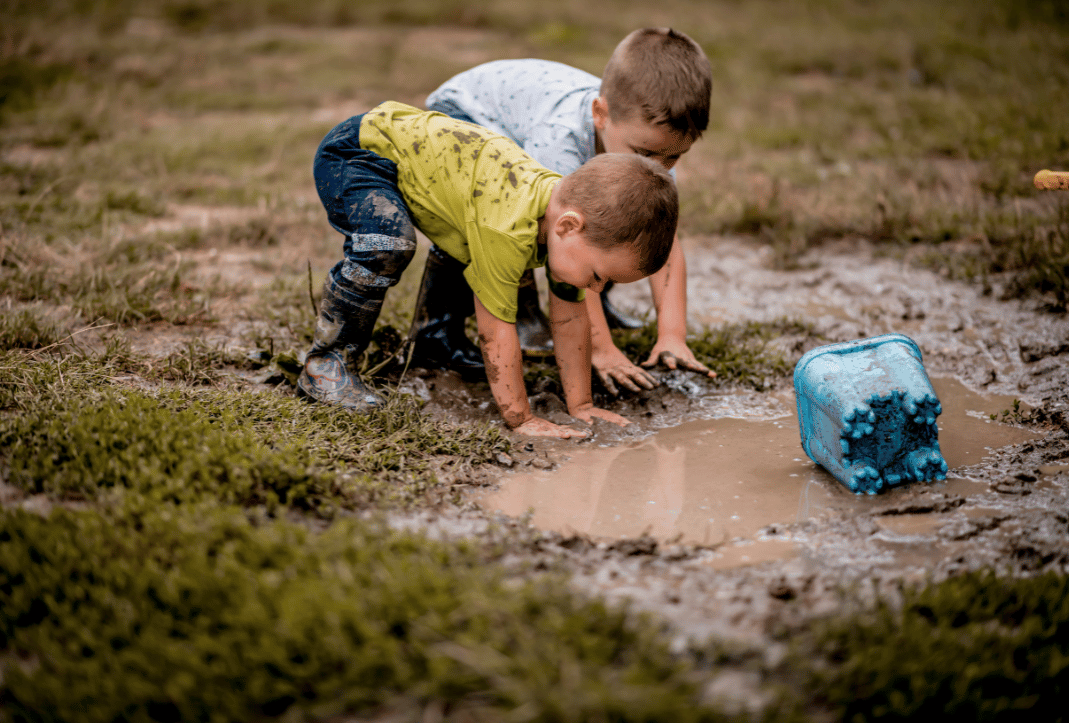I grew up in a small rural community fifteen minutes from the nearest grocery store. Like many country folk, we would only go into “town”–a city of about 5,000 people eleven miles to the north of us–on the weekend. Stops were carefully planned to ensure we got everything we needed. The last stop was always my grandma Mimi’s house. Here my mom and aunts would gather for hours to catch a break and update each other about their lives with the doors closed (and sometimes locked) so their children couldn’t come in and disrupt. This was grown-up time.
Outside, the oldest grandson–my brother–functioned as a semi-benevolent dictator directing the affairs of the able-bodied cousins (those who could confidently walk). There was a swing set, but it could only entertain a handful of us and only for about 15 minutes. After that, we traipsed through the woods looking for treasure. We traveled to distant places under my grandpa’s empty camper shell. And occasionally sojourned into the neighboring cemetery. The headstones were the backdrop where we perfected our storytelling skills as we explored death by making up what happened to the bodies that lay below the ground.
This form of unstructured free play is critical for our children’s mental, intellectual, and social development. And it’s in decline to all of our detriment.
What happens to the brain when children play?
Play is a critical part of becoming a fully-functioning living being. Play builds the architecture of the brain. It provides the experiences a child needs to build strong neural connections and networks. Just like science labs and field experiences provided a more meaningful learning experience for many of us in high school than copying definitions from a biology textbook, play provides context for learning and crucial brain activation.
Unstructured free play rewires the brain. Literally. When children engage in self-directed play–whether that’s “roughhousing” or negotiating rules of a made-up game in the back of a car on a road trip–the connections of the neurons at the front end of their brains change in ways that wire the brain’s executive control center. This executive control center plays an important role in regulating emotions, making plans, developing focus, strengthening working memory, and problem-solving. I don’t think it’s a coincidence that the decline in play has occurred alongside a decline in these skills.
Play builds social skills
We have a 4-year-old dog and a puppy at the Newcomb Farm right now. They are constantly moving. There is no end to their wrestling. It’s interesting to watch them, they seem to both intuitively know the rules of the game they are playing. Their play is intense and sometimes appears pretty aggressive. But the bigger one seems to be aware of the puppy’s limits without my intervention. He even seems a little remorseful when he goes too far and the puppy runs off howling. My husband would say I’m anthropomorphizing the dogs (assigning human emotion to animals).
It’s a little hard not to do so. The way those little squirrel dogs play looks very similar to how the Newcomb boys used to play when they were little. Experiments conducted with both animals and humans indicate that pretend play like this is useful for the development of emotional regulation, stress management, and other social skills. It doesn’t just have physical benefits but seems to help teach both humans and animals how to be social creatures.
Do children still play?
As idealistic–albeit occasionally morbid–as my recollection of my Saturday tromps in Mimi’s woods might be, I recognize the risks associated with this unsupervised play might strike horror in the hearts of modern parents. Generation Xers may have been the last generation to experience this type of unsupervised play. Those who didn’t grow up near woods might have found themselves riding bikes around the neighborhood, or playing baseball in the streets with other kids from the block. But even my cousins–only four or five years younger than me–have different memories of Mimi’s house. They played in the back room–in part, because the woods weren’t deemed safe.
The concern my aunts had for my younger cousins’ safety wasn’t an anomaly. It reflected a growing trend of fear in parenting that has resulted in–among other things–a decline in play.
Time logs of children’s activities taken in the early 2000s reported these children spent 50% less time in unstructured outdoor activities compared to children in the ’70s. This was before the advent of smartphones and tablets. It’s tempting to blame the rise of the cell phone or tablet on this phenomenon. Certainly, time once spent playing is now spent on a screen, but that doesn’t mean we can shoulder technology with all the blame. Parenting practices fueled by both fear and control seem to be an important factor here, as are school structures intended to improve standardized test scores.
Why don’t children play as much?
Children spend less time in spaces where free play occurs: the great outdoors. Children also have less free time in general. School days filled with fewer breaks and shorter recesses occupy more of the school year than previous generations. Once out of school, parents fill kids’ calendars with planned, structured activities. The free time they do have is increasingly spent on a screen. This propensity to spend time indoors in structured activity or on a screen has led to a more sedentary lifestyle that worsened during COVID but was going downhill before then.
Parental Fears
Parent concerns over safety are a major factor in the decline of play. Ninety-four percent of parents cite safety concerns–including both traffic and crime as a reason they restrict their children’s outdoor play. This makes more statistical sense in inner-city areas with less protected space devoted to community or public play areas. But as a child of the ‘80s, I think there’s also a connection to those scary documentary news shows that hooked our moms with stories of child kidnappings. But physical safety isn’t the only thing keeping children in structured activities.
The typical desire to see one’s child succeed seems increasingly distorted in the last few generations. The college cheating scandal highlights the near obsession some parents have with seeing their children achieve. Helicopter parents in the early 2000s fixated on their child’s academic or extracurricular achievements. Modern parents seem to have taken on a similar fixation with their child’s emotional achievement and expression.
You can blame millennial parents’ own childhood anxiety. Blame the parenting influencers’ on TikTok. Blame modern technology and the hyper-individualistic society it has produced. But parents today increasingly use the word “safety” to mean something other than freedom from physical harm. And parents are running ragged trying to ensure their children are kept “safe” from every type of danger: real or imagined.
Perhaps the otherwise sterile confines of indoor structured activity offer modern parents a convenient–and seemingly more productive–alternative to the wild and risky woods that gave my mother reprieve.
Or does it? There’s a growing sense from child development experts that the risks associated with the loss of play are quite a bit greater than previously understood. And our efforts to protect our kids may very well be one of the riskiest things we do as parents.
What happens when children don’t play?
Play expert Dr. Peter Gray has written about the importance of play in his book Free to Learn and his substack “Play Makes Us Human.” He has connected the generational and linear increase in anxiety, depression, feelings of helplessness, and narcissism over the last half century with the coinciding decline in play. His research suggests the underlying mechanism for this hyper-focus on self and the subsequent pathologies that follow are the likely outcomes of young adults who didn’t get the same opportunity to play that prior generations experienced.
When children play, Gray writes, they develop interests, skills, executive function, and important social skills like collaboration, self-control, and emotional regulation. He links the absence of these specific skills to the clinical symptoms of the various mental health diseases ticking upward over the last several generations. And he highlights how the increase in these mental health issues is mirrored by another trend: the decline in play.
I see his point and agree that just like lab rats, puppy dogs, and other mammals, children need play. When animals are deprived of playmates at a critical period of their development, they later overreact to stressful situations and cannot cope adaptively. Similar social, affective, and cognitive impairments are observed in rats. Perhaps children who miss out on the ancient childhood activity of play miss out on some key developmental experiences.
Can we change this?
It’s easy to blame cell phones and schools for the decline in play. Indeed, there are some things that schools can do that would be helpful. I also agree with Jonathan Haidt that phones are addictive and require parental intervention and oversight to decrease their use. But I don’t think we can (or should) totally reverse the use of cell phones and institutionalized school settings in our modern and highly literate world.
We might benefit from examining our parenting practices. Is our obsessive focus on giving our children a safe, happy, and risk-free life resulting in mental health problems? Parents seem to feel an imbalanced need to offer their child an unrealistic academic, social, emotional, and relational experience and intervene when it doesn’t reach standards of perfection. This is detrimental to parents and their children.
This week the Surgeon General issued an advisory on parents’ mental health. There’s no doubt parenting has become more complex over the last 5 decades. And I’m sincerely sympathetic to parents trying to navigate this moment on the planet with young children. But I also wonder if some of that complexity is a byproduct of our own choices and priorities. Specifically, in this area, could we simplify life in a way that might benefit us and our children?
For example, in the Surgeon General Advisory, one of the stressors impacting parents is time. Parents are working more outside the home and inside the home. Parents also spend substantially more time playing with their children. There are a lot of stressors we can’t change. But this seems like an area where we could take some pressure off.
Maybe we could focus on facilitating experiences that are physically safe, but still allow children an opportunity to try and fail. Give them a chance to come up with their own entertainment if they’re bored rather than offering another extracurricular activity. Allow them to navigate social conflict without our intervention. Maybe we could take a page from Mom and Mimi’s playbook and just let the little children play. It might do us all a little good.






One comment on “What happens when children play?”